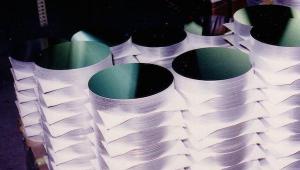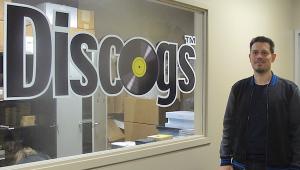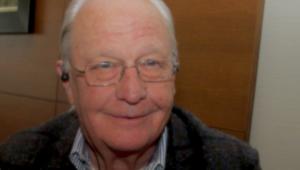Chico Hamilton Plays Demo Dates, "The Happy Whistler," "Ina Gadda Da Vida" and the Closing of Gold Star
FREMER: And they didn’t care about the master tapes?
ROSS: No, they couldn’t care less.
FREMER: So then who cut the lacquers for the records?
ROSS: I cut the lacquers off the mono, the mono mix.
FREMER: So you cut this lacquer that’s on this?
ROSS: Right.
FREMER: Right in your studio?
ROSS: Yeah, we had lathes.
FREMER: So “ATD” and “LW,” these are scribe marks that you put in there (on the album’s lead out groove area)?
ROSS: Yes.
FREMER: And then who did the plating and the pressing?
ROSS: AVCO, I think, then AFM in Hollywood. They did the plating and Monarch did the pressings in the same building. I don’t know if ATCO used them for New York. They used different presses all over the country. This is before they became Warner Brothers.
FREMER: Right. Of course.
ROSS: ATCO was an independent. Yeah, but all the Sonny and Cher stuff was mono.
FREMER: How big was Gold Star studio A (where all the major Spector, Valens, Sonny and Cher sessions were recorded) It was a small studio, correct?
ROSS: 28 by 35, with a 12 foot ceiling.
FREMER: That’s somewhat bigger than the size of my listening room but not by that much! And all those guys crowded in there and did all those recordings. And how big was your microphone complement?
ROSS: We had enough punch. We had good mikes, better than the amplifiers the musicians brought in. There were not many of them but it’s like “Zippity Do-Dah.” I always thought it was a wonderful story with the Bob E. Soxx and the Blue Jeans. Billy Strange did a guitar solo in the middle of the record and he had no mike. [LAUGHTER] He fuzz toned it.
FREMER: And it came through.
ROSS: It came through every mike. [LAUGHTER]
FREMER: Yeah, that’s fine.
ROSS: Every mike picked up on what he did. That’s a solo.
FREMER: So a lot of these were accidents? A lot of these great sounds were accidents?
ROSS: That's the thing I’m trying to get across is that when you do a demo and you make a master out of a demo, everything, every demo I’ve done that was a hit, it was an accident, but that was after a lot of experimenting so you could say it was a ‘planned accident!’ There’s a song that became “The Happy Whistler,” Don Robertson, 1960-something. I was experimenting with the echo while he was rehearsing the band, and I ran the tape as I was doing this and he’s walking around the room to the different musicians – there were only three guys: Chico Hamilton on drums, Red Callender on bass, and himself.
FREMER: That’s a nice grouping to play on your demo.
ROSS: Yeah, so he had just the three of them --
FREMER: Hey Chico, play on my demo of “The Happy Whistler?”
ROSS: Yeah, yeah, [LAUGHTER] and mind you, he walks around the room whistling this song to these guys and I’ve got the tape rolling with the echo and I’m experimenting and put the echo really big, and when he got done with this thing, I played this – his wife is sitting next to me at the time and she practically had a heart attack. She said this is unbelievable. So I called the musicians in the studio, I said come on in to the control room for a minute, and they said why, and I said I want you to hear something. What? I said I recorded what you just did. [LAUGHTER] What did we just do? Well, he’s walking around whistling the song to show the guys how it goes. So I played this back and all of a sudden I saw goose flesh come up on everybody’s arms and they’re listening to this thing they’ve never heard before. It was a record. It sounded like a drum corp. He’s playing the cadence and the bass is slapping the right notes, and Don is walking around whistling this thing without [UNCLEAR] whistling and slapping his knee and it sounded marvelous. We played it seven times. They didn’t want to go back in the studio and do it again so the only thing we did was we added keyboards, just block chords, and that’s it. He took it over to Capitol, to Voyle Gilmore that night; the next day it was coming out on Capitol as a release.
FREMER: That quickly.
ROSS: That quickly, and soon it was #1 or #2 on the charts. It’s the great old Hollywood story. The next week it was in the news!
FREMER: That will never happen again, that kind of thing.
ROSS: It’s the [degree of] response. Just like when I did the – well, I’m jumping too far really but when we did the Iron Butterfly, which one of our engineers, Jim Hilton did...
FREMER: “Ina Goda Da Vida”? ROSS: Yeah, “Ina Gadda Da Vida,” they put it on the air immediately; they knew they had a hit. FREMER: Because of that riff – da-da-da --
ROSS: Ina Goda Da Vida” – one cut. And the same thing with the big hit for Buffalo Springfield, “For What It’s Worth, I produced that one even though it wasn’t done at Goldstar.
FREMER: Really?
ROSS: I arranged the tune as well. They didn’t have – they were calling me up at the studio, come on over, we’re over at Columbia making this record, and I’m working with Sonny at the studio cutting – we’re having the Sunset Boulevard riots, so Sonny came into the studio, [sang] “You Better Sit Down, Kids” or something. FREMER: What was that again?
ROSS: “You Better Sit Down, Kids.” He did a record, Sonny. He was advised by Atlantic to do that, to go over there and make a record to calm the kids down. And it worked! The kids were rioting on Sunset Strip. FREMER:. This is ’67.
ROSS: Whiskey A Go-Go and all that, yeah. And they were rioting on Sunset Strip so Sonny called me up and they wanted him to come in the studio and do a song about it so the kids would calm down.
FREMER: Right, like that would work, yeah.
ROSS: Well, yeah. It worked in this case because the kids were hanging up in trees and everything at the time. Well, anyway, I worked with Sonny that night and I got a call from Charlie Green and Brian Stone who were doing the Buffalo Springfield at Columbia. They wanted me to come over there, they were having a problem getting the sound. So at 11:30 at night I’m over at CBS on Sunset. I walk in there, they’re all sitting around smoking joints and the engineer’s sitting reading the paper with his feet up on the console. I said this is no way to make a hit. I got two hours and I got to go home and go to bed. So I walked in there and I said let me hear the song so Neil or somebody sang the song for me and I said I’ve got a good idea for the drum line. And the drummer was out of his mind at that point. He wasn’t with it. So I took the hand mallets and I said give me one track of just this and I played the hand mallet for tempo for the [kick] drum. And I took the guy’s guitar and wrapped it with paper, the frets, the acoustic guitar, and they hadn’t scratched the rhythm sound.
FREMER: What made you think of that?
ROSS: Because I’d done it on demos. All these sounds that I knew, these are things I’ve done over the years, so I had the guy scratch the sound on the guitar frets with the hard pick and with that kick drum thing it was a rhythm sound. Then they added some other – some regular guitar, and then they put the chords – I said now put the chords in after the vocal goes on. The chords are then put to the choral background and clap their hands in the two spots. They did that, I said I’m not going to stay any longer. I’m gone. The next morning I get a phone call from Ahmet Ertegun. He says I want you and Phil to listen to the final mix. He said whatever you guys pick is the one we’ll use. So Phil came down to the studio. At that time he was logic headed. Phil was okay in the morning so he came down to Gold Star about 10 o'clock in the morning because he loved Ahmet Ertegun. We played the two mixes from Columbia and we picked the mix and that was it. That’s the record, for what it’s worth.
FREMER: The single.
ROSS: The only hit they ever had.
(Publicist PHIL CALLAHAN): Yes, that was it, a monster, too. Defined an era.
FREMER: So the studio was open from what year to what year?
ROSS: 33 and 1/3 years, from June, 1950 to October, 1983.
FREMER: And the building got torn down or what happened?
ROSS: No, we sold the building.
FREMER: You owned the building.
ROSS: We owned the property.
FREMER: So it was more worthwhile to --
ROSS: We owned 55,000 square feet from Santa Monica Boulevard east and west and south, that whole area, the parking lot, the whole thing. It was ours. And it was time to move because I was getting tired and -- FREMER: Could you have sold it and the studio stayed open or was it just reaching a period of time where it -- ROSS: No, what happened was everybody had their own studios in their garage. Now, musicians were now my competitors. All these wonderful guys who used to come in and do great stuff, Tim May and all these guys, wonderful stuff in the studio and now we’re doing it at home. Actually, what happened was, after we sold it, the whole building burned down! David and I went down there on Sunday after the fire and the only thing left standing were the two echo chambers, because they were concrete! Now what was inside the chamber that gave it that special sound was a chemical formulation that Dave Gold invented that he wouldn’t tell anyone about. It was a secret. He was offered a lot of money by A&M to build one, but he wouldn’t do it. Only one celebrity, Maurice Gibb of the Bee Gees, saw inside the chamber. Dave took him on a tour in 1983 and unlocked the echo chamber. He’s the only one.
FREMER: ’83 this was? Yeah, I was living in LA at that point in time.
ROSS: They were doing things at home. I said, you know, I don’t play guitar. I’m not a record label. So I’m trying to make a living out of this and I can’t. If they’re going to be doing my business and I can’t do it, I can’t compete. So it was becoming a little bit of a hassle.
FREMER: What records did Phil Spector do there, all the big ones?
ROSS: I cut his first record, “To Know Him is to Love Him,” The Teddy Bears.
FREMER: Oh, you cut that one, too? Oh. Don’t hold back this stuff.
ROSS: Back in the old days.
FREMER: That sounded really good by the way. I found it on a single and it sounds incredibly good.
ROSS: That was the back side. That’s a story by itself. I won’t get into that. But “To Know Him is to Love Him” was the back side. We knocked it off in twenty minutes!
FREMER: And that was done at Gold Star? That was early.
ROSS: Oh, yeah, that was early for him. Not for us, we were around for a few years already. But we did “To Know Him is to Love Him.”
FREMER: And how did he end up at the studio?
ROSS: He had gone to Fairfax (High School) and heard that I was a Fairfax alumni.
FREMER: Be true to your school, right? [LAUGHTER]
ROSS: Yeah, be true to your school. He heard that I had gone to Fairfax.
- Log in or register to post comments




















































